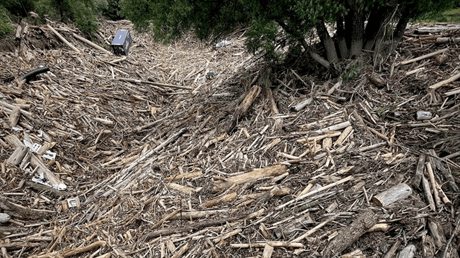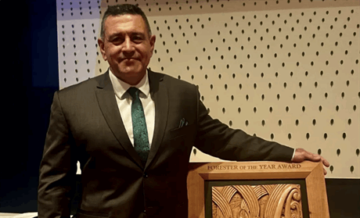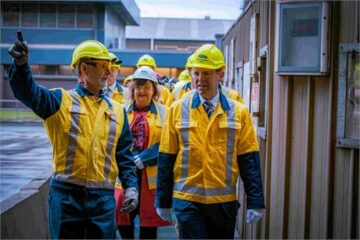
Tairāwhiti residents are furious that pine plantation owners are pushing back against rule changes to protect catchments from the impacts of harvest slash and sediment, and are calling for a halt to new forestry plantings.
Hera Ngata-Gibson, Mana Taiao Tairāwhiti spokesperson, says tensions are running so high that the community might take the law into their own hands if land use changes don’t go far enough.
“Whether you start seeing forest burn or other sorts of action, there comes a point where people are fed up and they do things they wouldn’t otherwise do.”
The group wants to see an immediate end to new forestry plantings. “Until we put an end to new plantations we can only plan our way out of the mess. Every new rotation [of planting] our people are committed to decades more of this mess.”
She says the feeling in communities is that people have had enough. “If the industry thinks they can just continue like they’ve always done, they’ve got another think coming. I can definitely tell you our communities will get off their bums and do something physical about it. People will mobilise.”
Tens of millions of tonnes of silt and woody debris have come off Tairāwhiti’s hills over the past ten years, causing billions of dollars worth of property damage as well as ecological destruction. Thirty-six million tonnes of sediment entered Tairāwhiti waterways in 2022 alone – even before the widespread destruction caused by Cyclone Gabrielle.
“It’s one thing to have crazy weather but we’ve had two decades of slash and erosion issues,” Ngata-Gibson says. “It took Gabrielle to really open the can of worms. But our communities on the coast have been putting up with it for decades.”
Ngata-Gibson started a petition last year, which was signed by over 12,000 people, and led to an independent government inquiry into land use in the region following Cyclone Gabrielle. However recommendations from the inquiry have yet to be enacted.
Meanwhile, two Gisborne forestry companies have recently lost their sustainability accreditation for events in 2018.
Mana Taiao Tairāwhiti has campaigned for Gisborne District Council to review and update the district land use rules for pasture and pine plantations on erosion prone land that makes up nearly 90% of the region.
However Eastland Wood Council chair Warren Rance last week said that proposed rules to reduce the scale of clear felling of pine plantations on erosion-prone land could severely affect the economic viability of plantation operations “by restricting operational flexibility”.
Ngata-Gibson says it is “unbelievable” to hear the head of the local industry say they don’t want these changes.
“The Council is saying pine trees can be planted and harvested where it can be done sustainably, that is, on land that is not erosion-prone. That means a much smaller footprint for the industry in this region and we all better get used to that fact and fast.”
She says the region is facing a huge challenge with more than 100,000 hectares of existing pine plantations that will present risks if they are harvested.
Changes to the forestry industry will also impact the local port. “I don’t know why they need to spend $50m of our money on a wharf extension when the number of ships coming to collect logs is going to drop very fast,” Ngata-Gibson says.
The group is exploring options for sustainable management of legacy trees to replace them with diverse permanent indigenous forest. “We look forward to getting around the table with the companies, regulators and central government officials to discuss these options and for a range of reasons it feels like that should happen sooner than later,” Ngata-Gibson says.
Elizabeth Heeg, Forest Owners Association chief executive officer, says the forestry industry, in Gisborne and nationally, is committed to implementing lessons to improve outcomes. “This has been demonstrated through our commitment to collaborate with not only Gisborne District Council, but also with communities, iwi, mana whenua and central government. The most balanced approach would be through real engagement with the range of stakeholders to achieve the most enduring and sustainable outcomes.”
She says foresters are open to possible land use change and if required, on a case by case basis, a transition to sustainable alternatives. “In many cases we have and will continue to voluntarily transition land. We truly believe that in many cases, in the absence of a tried and viable alternative, trees provide the best protection from erosion.
“We are committed to applying the best science available, developing research and transition methodologies in order to understand and develop alternative land uses, species or forestry systems to achieve this.”
Heeg says foresters are collaborating with other groups to get the regulations right. “We remain focused on collaboration with the Gisborne District Council and other stakeholders, to form regulations that are enabling, achievable and sustainable.
“This work is in process and progress is being made. As it should be, this process is careful and considered.”
She wants to see Mana Taiao Tairāwhiti take part in a “robust dialogue” to make sure that changes are well considered in terms of the science and future needs of the economy, land and people.
“We welcome this group, along with any other interested stakeholders to contribute, with an open mind, to the range of working groups being designed to achieve this.”
- SEO Powered Content & PR Distribution. Get Amplified Today.
- PlatoData.Network Vertical Generative Ai. Empower Yourself. Access Here.
- PlatoAiStream. Web3 Intelligence. Knowledge Amplified. Access Here.
- PlatoESG. Carbon, CleanTech, Energy, Environment, Solar, Waste Management. Access Here.
- PlatoHealth. Biotech and Clinical Trials Intelligence. Access Here.
- Source: https://www.carbonnews.co.nz/story.asp?storyID=31463
- :has
- :is
- :not
- :where
- $UP
- 000
- 1
- 10
- 100
- 12
- 121
- 2018
- 2022
- 32
- 5
- a
- About
- about IT
- absence
- achievable
- Achieve
- Action
- affect
- against
- All
- along
- also
- alternative
- alternatives
- always
- an
- and
- Another
- any
- Applying
- approach
- ARE
- around
- AS
- Association
- available
- back
- balanced
- basis
- BE
- been
- before
- being
- believe
- BEST
- Better
- billions
- burn
- but
- by
- calling
- CAN
- careful
- case
- cases
- caused
- causing
- central
- Chair
- challenge
- change
- Changes
- chief
- Chief Executive
- chief executive officer
- clear
- CO
- Coast
- collaborate
- collaborating
- collaboration
- collect
- come
- comes
- coming
- commitment
- committed
- Communities
- community
- Companies
- considered
- continue
- contribute
- could
- Council
- crazy
- damage
- decades
- definitely
- demonstrated
- designed
- destroy
- develop
- developing
- discuss
- district
- diverse
- do
- dollars
- done
- Dont
- Drop
- East
- east coast
- Ecological
- Economic
- economy
- enabling
- end
- enduring
- engagement
- enough
- entered
- Even
- events
- Every
- executive
- Executive Officer
- existing
- Exploring
- extension
- facing
- fact
- far
- FAST
- Fed
- feeling
- feels
- focused
- following
- Footprint
- For
- forest
- form
- Forward
- from
- future
- get
- getting
- Go
- going
- got
- Government
- Government Officials
- Group
- Group’s
- had
- Hands
- happen
- harvest
- Have
- head
- hear
- High
- Hills
- However
- HTTPS
- huge
- i
- if
- immediate
- Impact
- Impacts
- implementing
- improve
- in
- industry
- inquiry
- interested
- into
- issues
- IT
- just
- Know
- Land
- Last
- Last Year
- later
- Law
- Led
- Legacy
- Lessons
- like
- local
- Look
- lost
- made
- make
- MAKES
- MANA
- management
- many
- means
- methodologies
- might
- million
- millions
- mind
- money
- more
- most
- much
- nationally
- nearly
- Need
- needs
- New
- normal
- number
- of
- off
- Officer
- officials
- on
- ONE
- only
- open
- operational
- Operations
- Options
- or
- order
- Other
- otherwise
- our
- out
- outcomes
- over
- own
- owners
- part
- past
- People
- permanent
- physical
- plan
- plantation
- Planting
- plato
- Plato Data Intelligence
- PlatoData
- Point
- possible
- present
- process
- Progress
- property
- proposed
- protect
- protection
- provide
- Pushing
- put
- Putting
- range
- real
- really
- reasons
- recommendations
- reduce
- region
- regulations
- Regulators
- remain
- replace
- required
- research
- residents
- restricting
- review
- right
- risks
- Rule
- rules
- running
- say
- saying
- says
- Scale
- Science
- see
- seeing
- severely
- ships
- should
- signed
- smaller
- So
- something
- spend
- spokesperson
- stakeholders
- start
- started
- sure
- Sustainability
- sustainable
- sustainably
- Systems
- table
- Take
- tell
- ten
- tensions
- terms
- than
- that
- The
- the Law
- their
- Them
- There.
- These
- they
- thing
- things
- Think
- Thinks
- this
- Through
- to
- took
- transition
- Trees
- tried
- truly
- two
- understand
- Update
- use
- used
- uses
- very
- viability
- viable
- voluntarily
- want
- wants
- warren
- was
- Way..
- we
- Weather
- week
- welcome
- WELL
- when
- which
- why
- widespread
- will
- with
- wood
- Work
- working
- Working Groups
- worms
- worth
- would
- year
- years
- yet
- you
- zephyrnet












